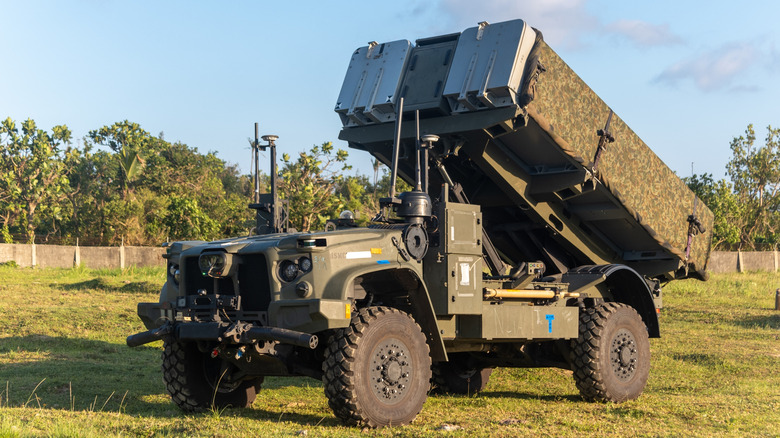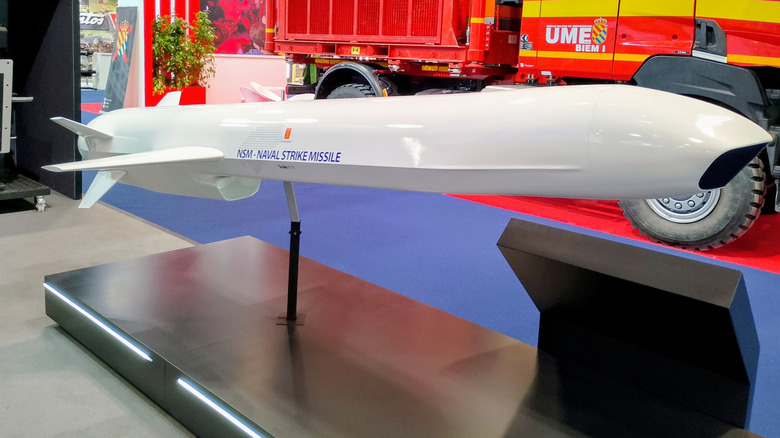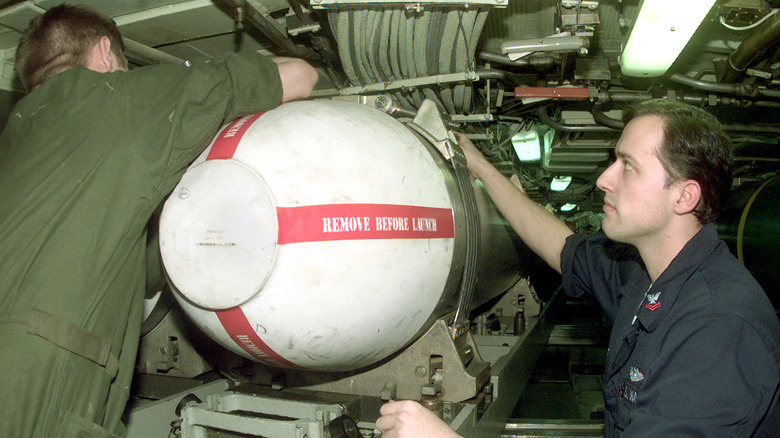What Is The NMESIS Missile And Why Is The US Marine Corps Choosing It Over Tomahawks?
It's no secret that the United States military invests serious, serious money into the nation's operations and defense. A budget of several billion might seem almost limitless to many, but it's still crucial to prioritize those weapons, vehicles, and technologies that are best suited to U.S. priorities. According to Naval News, the Marine Corps' budget report for the fiscal year of 2026 parts ways with a very well-known weapon system: the Tomahawk missile.
The focus, instead, is on the NMESIS (Navy-Marine Expeditionary Ship Interdiction System). This armament, as its name would imply, is sure to be the nemesis of many a surface vessel. It consists of the remote controlled ROGUE Fires Carrier, which is equipped with a launcher for the formidable Naval Strike Missile. Together, they make for a highly mobile weapon that provides a vital capacity: Targeting opposing ships in a more dedicated role that Tomahawk missiles aren't (specifically) designed for.
The primary advantage of the NMESIS system is that it's designed to be fired from the ground to the sea, which isn't the traditional domain of the Tomahawk. Perhaps it may have been, but the BGM-109G Gryphon, a variant of the missile that was fired in this manner, was shelved as a result of 1988's Intermediate-Range Nuclear Forces Treaty. This agreement, according to The War Zone, prevented nations from owning ground-launched missiles with ranges between 310 and 3,420 miles, whether they were nuclear-equipped or not. The agreement dates back to the closing years of the Cold War, and in October 2018, President Donald Trump declared, via Time, "We're going to terminate the agreement and we're going to pull out." In doing so, the United States set the stage for the NMESIS, presently considered the right weapon for the Marine Corps' ongoing strategy.
How the NMESIS system might fit into U.S. Marine Corps strategy
Speaking to the Senate Armed Services Committee in 2018, U.S. Navy Admiral Harry Harris lamented, according to The War Zone, the fact that the INF treaty left the United States with "no ground-based capability that can threaten China." The Naval Strike Missile, pictured above, would be an ample armament with which to allay any such concerns. Deterring any opposing action by displaying exactly why it would be a bad idea is what the concept of Force Design 2030 is all about. As Karsten Heckl, Lieutenant General of the Marine Corps, put it to The War Zone, "Being forward inside the weapons engagement zone, with allies and partners, reassuring them every day, by walking the real estate with them, that is deterrence."
The idea revolves around having important assets and personnel already in important positions, because, the outlet notes, "it is better for Marines to be forward than to fight their way in." This is just the sort of use that the NMESIS can be put to. The NMESIS systems, deployed on the Luzon Strait, had an excellent position in a very strategic position, and the ability to potentially reach any vessel passing in the region of Taiwan has tremendous strategic value. What matters the most is how well a weapon's specs fit the needs of the military, and how it aligns with their current and future goals and aims. This is a crucial reason why the Marine Corps is so committed to the NMESIS system in the FY2-2026 budget, and why it hasn't requested any Tomahawk missiles in it. The force isn't afraid to drop weapons it doesn't deem fitting, with the U.S. Marine Corps also stopping using tanks.
The trouble with the Tomahawk
The Tomahawk missile, originally developed by General Dynamics, is a cruise missile that has a considerable range of up to approximately 1,500 miles. It was first used in combat in 1991, during Operation Desert Storm. It has become well known for its versatility, with manufacturer Raytheon boasting that the wider Tomahawk family can be launched at sea, by submarines, and on the ground alike.
The Marine Corps originally envisioned it fulfilling the ground-launched role. In fact, in July of 2023, the Marine Corps celebrated its first Tomahawk battery, noting, per USNI News, that such developments would provide "the ability to employ an agile, mobile, land-based system, capable of launching Tomahawk cruise missiles to complement surface and sub-surface launched missiles." For the marines specifically, though, 2026 will see a shift away from this battle-tested missile.
Naval News quotes a USMC document relating to the fiscal year's budget as underscoring the reason why. Its testing concluded that a Long Range Fires system utilizing Tomahawk missiles, "was not able to be employed in austere, expeditionary, littoral environments." At the time of writing, then, the Marine Corps is committing to NMESIS missile system, its careful global positioning potential key to USMC strategy for the foreseeable future. Tomahawk cruise missiles may have given battleships a second life, but they aren't presently the marines' weapon of choice.


